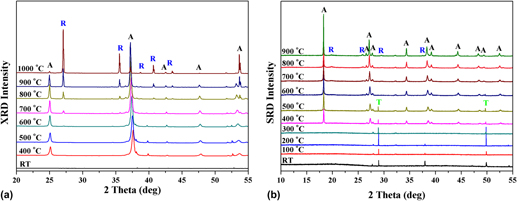Article contents
Effect of indium ion implantation on crystallization kinetics and phase transformation of anodized titania nanotubes using in-situ high-temperature radiation diffraction
Published online by Cambridge University Press: 11 March 2016
Abstract

Titania nanotube arrays were synthesized electrochemically by anodization of titanium foils, and the synthesized titania nanotubes were then implanted with indium ions. The effect of In-ions implantation on crystallization and phase transformation of titania was investigated using in-situ high-temperature X-ray diffraction and synchrotron radiation diffraction from room temperature to 1000 °C. Diffraction results show that crystalline anatase first appeared at 400 °C in both the non-implanted and the In-implanted materials. The temperature at which crystalline rutile temperature appeared was 600 °C for non-implanted materials and 700 °C for In-implanted materials, and the indium implantation inhibited the anatase-to-rutile transformation. Although In3+ is expected to increase oxygen vacancy concentration and then the rate of titania transformation, the observations are consistent with implanted In-ions occupying the Ti sublattice substitutionally and then inhibiting the transformation. The relatively difficult anatase-to-rutile transformation in the In-implanted material appears to result from the relatively large In3+ radius (0.080 nm). The In3+ partly replaces the Ti4+ (0.061 nm), which provides a greater structural rigidity and prevents relaxation in the Ti bonding environment.
- Type
- Articles
- Information
- Journal of Materials Research , Volume 31 , Issue 11: Focus Issue: Advanced Materials and Structures for Solar Fuels , 14 June 2016 , pp. 1588 - 1595
- Copyright
- Copyright © Materials Research Society 2016
References
REFERENCES
- 9
- Cited by


